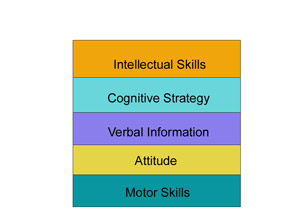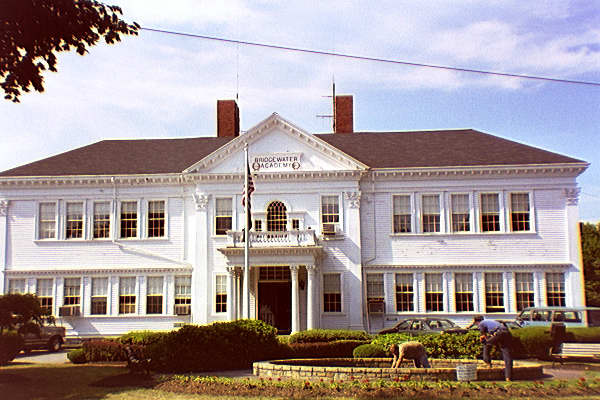Gagné's Five Learned Capabilities |
The classification of learning according to Robert Gagné includes five kinds of learned capabilities: intellectual skills, cognitive strategies, verbal information, attitudes, and motor skills. The Gagné taxonomy is perhaps the most popular of the many learning taxonomies in the field of instructional design (Reigeluth, 1983). It's popularity can be attributed best for its ability to clearly distinguish between abstract and concrete definitions of learning (Seels & Glasgow, 1990).
 Motor
Skills refers to bodily movements involving muscular activity.
Examples might be: Starting a car, shooting a target, swinging a golf club.
Motor
Skills refers to bodily movements involving muscular activity.
Examples might be: Starting a car, shooting a target, swinging a golf club.
Attitude is an internal state which affects an indiviudal's hoice of action toward some object, person, or event. Examples might be: Choosing to visit an art museum, writing letters in pursuit of a cause.
Verbal Information include: 1) Labels and Facts and 2) Bodies of Knowledge.
1) Labels and facts refer to naming or making a verbal response to a specific input. The response may be naming or citing a fact or set of facts. The repsonse may be vocal or written. Examples: Naming objects, people, or events. Recalling a person's birthday or hobbies. Stating the capitals of the United States.
2) Bodies of Knowledge refers to recalling a large body of interconnected facts. Example: paraphrasing the menaing of textual materials or stating rules and regulations. Example: Paraphrasing the menaing of textual materials. Stating rules and regulations.
Cognitive Strategy is an internal process by which the learner controls his/her own ways of thinking and learning. Example: Engaging in self-testing to decide how much study is needed; knowing what sorts of questions to ask to best define a domain of knowledge; ability to form a mental model of the problem.
Intellectual Skills include 1) Discrimination 2) Concrete concept 3) Rule using and 4) Problem solving. These are the four levels within the intellectual skills domain that Gagné identified as his taxonomy.
 Discrimination
is making different responses to the different members of a particular class.
Seeing the essential differences between inputs and responding differently
to each. Example: Distinguishing yellow finches from house finches on the
basis of markings; having to tell the differences between gauges on an instrument
panel.
Discrimination
is making different responses to the different members of a particular class.
Seeing the essential differences between inputs and responding differently
to each. Example: Distinguishing yellow finches from house finches on the
basis of markings; having to tell the differences between gauges on an instrument
panel.
Concrete concept is responding in a single way to all members of a particular class of observable events. Seeing the essential similarity among a class of objects, people, or events, which calls for a single response. Example: Classifying music as jazz, country western, rock, etc.; saying "round upon seeing a manhole cover, a penny, and the moon.
Rule using is applying a rule to a given situation or condition by responding to a class of inputs with a class of actions. Relating two or more simpler concepts in the particular manner of a rule. A rule states the relationship among concepts. Examples: It is helpful to think of rules or principles as "if-then" statements. "If a task is a procedure, then use flowcharting to analyze the task." "If you can convert a statement into an 'if-then' statement, then it is a rule or principle."
Problem solving is combining lower level rules to solve problems in a situation never encountered by the person solving the problem. May involve generating new rules which receive trial and error use until the one that solves the problem is found.
Reference:
Gagné, R.M. and Briggs, L.J. (1974). Principles of instructional design (2nd ed.). Holt, Rinehart, and Winston.
Seels and Glasgow (1990). Exercises in instructional design. Columbus OH: Merrill Publishing Company.
Return to Perform a Task Analysis
 |
| HOME |